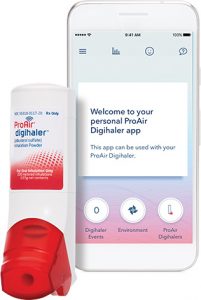
ProAir Digihaler
Integrated adherence monitors in asthma and COPD inhalers are on the horizon and clinicians should do all they can to support their development and adoption.
A call-to-action, published in JAMA in response to recent FDA approval of the first such inhaler – Teva’s ProAir Digihaler (albuterol sulfate 117mcg) – said integrated adherence monitoring was ‘desirable, feasible and achievable’.
Associate Professor Mark Hew, from the Alfred Hospital and Monash University, and Professor Helen Reddel, from the Woolcock Institute of Medical Research, wrote that relying on patient report of adherence was outdated.
“Clinicians should no longer accept the current lack of adherence monitoring for patients with asthma and COPD, and they should encourage pharmaceutical companies to rectify this, consider choosing inhaler systems with monitoring (provided clinical benefit and cost effectiveness can be demonstrated), require industry to provide a common compatible data platform, and expect seamless data integration with electronic medical records,” they said in the Opinion article.
Speaking to the limbic, Associate Professor Hew said that while add-on electronic adherence monitors for existing inhaler devices were available, at least in the US, they were cumbersome, not 100% reliable and patients sometimes misplaced them.
“It would be great if the pharmaceutical companies go straight to integrated monitoring. It would also be cheaper than add-on technology.”
However he warned there was a risk that the technology could go down a fragmented pathway as has happened with CPAP.
“CPAP monitoring works well because every company does have in-built monitoring but the downside is that each company requires different software to access the monitoring. So if you run a sleep clinic, you need several different systems installed on your machinery to download data.”
However he was hopeful that it may be possible for industry to develop a common platform and still have their products remain competitive.
From a research point of view, there was also a need to demonstrate the effectiveness of clinical systems to respond to the detection of poor adherence.
“Measuring adherence by itself without the ability to respond to poor adherence is useless. We need to test clinical programs in a variety of settings to show that adherence monitoring can be used to modify patient behaviour and improve patient outcomes.”
“In addition, we need to accumulate evidence on cost effectiveness.”
He said adherence monitoring could benefit all patients but was most likely to be cost effective in patients with severe disease.
“In the study of severe asthma we cited, the detection of poor adherence focussed more attention on improving adherence to current medication, rather than moving onto biologics.”
He said the cost of integrated adherence monitoring would be a fraction of the cost of biologics.
“In the meantime, until the technology reaches us, then we have to be aware that poor adherence is important and we have to use our clinical skills to try and elicit that from the patients in a non-threatening fashion. Equally important is attention to inhaler technique.”
Disclosure: Professor Reddel has reported receiving fees for providing independent medical education at symposia funded by pharmaceutical companies including Teva.